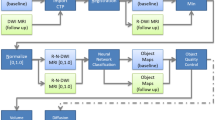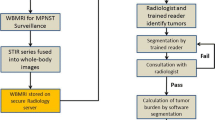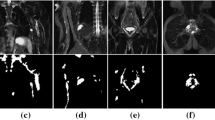Abstract
Plexiform neurofibromas (PNs) are a major manifestation of neurofibromatosis-1 (NF1), a common genetic disease involving the nervous system. Treatment decisions are mostly based on a gross assessment of changes in tumor using MRI. Accurate volumetric measurements are rarely performed in this kind of tumors mainly due to its great dispersion, size, and multiple locations. This paper presents a semi-automatic method for segmentation of PN from STIR MRI scans. The method starts with a user-based delineation of the tumor area in a single slice and automatically segments the PN lesions in the entire image based on the tumor connectivity. Experimental results on seven datasets, with lesion volumes in the range of 75–690 ml, yielded a mean absolute volume error of 10 % (after manual adjustment) as compared to manual segmentation by an expert radiologist. The mean computation and interaction time was 13 versus 63 min for manual annotation.






Similar content being viewed by others
References
Alnuweiri H, Prasanna V (1992) Parallel architectures and algorithms for image component labeling. IEEE Trans Pattern Anal Mach Intell 14:1014–1034
Cai W, Kassarjian A, Bredella M, Harris G, Yoshida H, Mautner V, Wenzel R, Plotkin S (2009) Tumor burden in patients with neurofibromatosis types 1 and 2 and schwannomatosis: determination on whole-body MR images. Radiology 250:665–673
Colleweta G, Strzeleckib M, Mariettea F (2004) Influence of MRI acquisition protocols and image intensity normalization methods on texture classification. Magn Reson Imaging 22:81–91
Corso J, Sharon E, Dube S, El-Saden S, Sinha U, Yuille A (2008) Efficient multilevel brain tumor segmentation with integrated bayesian model classification. IEEE Trans Med Imaging 27(5):629–640
Dombi E, Solomon J, Gillespie AJ et al (2007) NF1 plexiform neurofibroma growth rate by volumetric MRI: Relationship to age and body weight. Neurology 68:643–647
Farmaki C, Marias K, Sakkalis V, Graf N (2010) Spatially adaptive active contours: a semi-automatic tumor segmentation framework. Int J Comput Assist Radiol Surg 5(4):369–384
Foo T, Hayes C, Kang YW (1992) Reduction of RF penetration effects in high field imaging. Magnet Reson Med 23:287–301
Gerig G, Jomier M, Chakos M (2001) Valmet: a new tool for assessing and improving 3D object segmentation. Lect Notes Comput Sci 2208:516–523
Huson S, Hughes R (1994) The neurofibromatoses: a pathogenetic and clinical overview. Chapman and Hall, London
Jager F, Hornegger J (2009) Nonrigid registration of joint histograms for intensity standardization in magnetic resonance imaging. IEEE Trans Med Imaging 28:137–150
Kanungo T, Mount D, Netanyahu N, Piatko C, Silverman R, Wu A (2002) An efficient k-means clustering algorithm: analysis and implementation. IEEE Trans Pattern Anal Mach Intell 24(7):881–892
Lammert M, Friedman J, Kluwe L, Mautner V (2005) Prevalence of neurofibromatosis 1 in german children at elementary school enrollment. Arch Dermatol 141:71–74
Lingurarua MG, Yao J, Gautam R, Peterson J, Li Z, Linehan WM, Summers RM (2009) Renal tumor quantification and classification in contrast-enhanced abdominal CT. Pattern Recognit 42(6):1149–1161
Mautner V, Asuagbor F, Dombi E, Fnsterer C, Kluwe L, Wenzel C, Widemann B, Friedman JM (2008) Assessment of benign tumor burden by whole-body MRI in patients with neurofibromatosis 1. Neuro-Oncology 10:593–598
Poussaint T, Jaramillo D, Chang Y, Korf B (2003) Interobserver reproducibility of volumetric mr imaging measurements of plexiform neurofibromas. AJR 180:419–423
Prastawa M, Bullitt E, Bullitt N, Leemput K, Gerig G (2003) Automatic brain tumor segmentation by subject specific modification of atlas priors. Acad Radiol 10:1341–1348
Prastawa M, Ho S, Gerig G (2004) A brain tumor segmentation framework based on outlier detection. Med Image Anal J 8(3):275–283
Shaha M, Xiaoa Y, Subbannaa N, Francisb S, Arnoldb DL, Collinsb DL, Arbela T (2011) Evaluating intensity normalization on MRIs of human brain with multiple sclerosis. Med Image Anal 15:267–282
Solomon J, Warren K, Dombi E, Patronas N, Widemann B (2004) Automated detection and volume measurement of plexiform neurofibromas in neurofibromatosis 1 using magnetic resonance imaging. Comput Med Imaging Graph 28:257–265
Solomon J, Butman JA, Sood A (2006) Segmentation of brain tumors in 4D MR images using the hidden markov model. Comput Methods Programs Biomed 84(2-3):76–85
Tucker T, Friedman J, Friedrich R, Funstere C, Mautner V (2009) Longitudinal study of neurofibromatosis 1 associated plexiform neurofibromas. J Med Genet 46:81–85
van Horssen P, Siebes M, Hoefer I, Spaan J, van den Wijngaard J (2010) Improved detection of fluorescently labeled microspheres and vessel architecture with an imaging cryomicrotome. Med Biol Eng Comput 48:735–744
Weisenfeld NL, Warfield SK (2004) Normalization of joint image-intensity statistics in MRI using the Kullback–Leibler divergence. Proceedings of IEEE international symposium on biomedical imaging: nano to macro (ISBI). vol 1, pp 101–104
Williams V, Lucas J, Babcock M, Gutmann D, Korf B, Maria B (2009) Neurofibromatosis type 1 revisited. Pediatrics 123:124–133
Woodruff J (1999) Pathology of tumors of the peripheral nerve sheath in type 1 neurofibromatosis. Am J Med Genet 89:23–30
Acknowledgments
The authors wish to thank the Gilbert Israeli Neurofibromatosis Center (GINFC), for providing the real data and for supporting the medical aspects of the paper.
Author information
Authors and Affiliations
Corresponding author
Rights and permissions
About this article
Cite this article
Weizman, L., Hoch, L., Ben Bashat, D. et al. Interactive segmentation of plexiform neurofibroma tissue: method and preliminary performance evaluation. Med Biol Eng Comput 50, 877–884 (2012). https://doi.org/10.1007/s11517-012-0929-1
Received:
Accepted:
Published:
Issue Date:
DOI: https://doi.org/10.1007/s11517-012-0929-1




